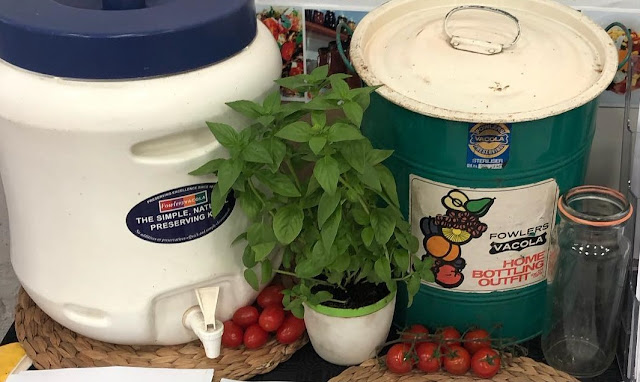Fowlers Vacola, an
Australian preserving company, has two electric unit models (and a stove top model),
which heat jars of fruit/pickles up over 60-90 minutes to process and seal jars
prior to pantry storage. You can use Fowlers Vacola bottles (you’ll need bottles,
rings, lids and clips) - or any other
jars that are suitable for water bath canning - in a Fowlers Vacola Preserver.
1. Place a preserving ring onto each Fowlers
jar/bottle.
![Position a lid onto each jar [GOOGLE IMAGE]](https://blogger.googleusercontent.com/img/b/R29vZ2xl/AVvXsEiKMJagUuYG-MFb7smpTdPotmDjBiifIlNMzjUwjEKoajMV0IBBM1VjFngdiV7qiWdKP6QBZTwYmedrVsn2jR27e5bUIpNgpjz0cyFY2eMqp4Ls5VSji4uIkQEf5pH1ft5ZG3B2zKf96FTT7URFO4XlZIfpUHWNnQ-TngzDA6tuTrQ_r49ROESeauLaJw/w183-h200/fowlers%20vacola%20lids.jpg) 2. As per water bath canning recipe, prepare fruit/pickle and place
into jars at room temperature (if boiling hot, cool until warm then fill jars).
Add required liquid – water, juice or syrup for fruit, pickling brine for
pickles).
2. As per water bath canning recipe, prepare fruit/pickle and place
into jars at room temperature (if boiling hot, cool until warm then fill jars).
Add required liquid – water, juice or syrup for fruit, pickling brine for
pickles).3. Remove air pockets from each jar and ensure
jars are filled to 12mm (1/2 inch) from the rim.
4. Position a lid onto each jar and add one clip
onto each lid, to secure the lid to the jar.
6. Turn on preserver and set your timer for the
time required (60-90 minutes, as per Fowlers Vacola instructions).
7. Once jars have finished processing, carefully
remove them from the preserving unit with jar tongs. Place jars onto a heatproof
surface i.e. towel or wood board. Do not remove clips.
8. Leave jars
to cool for 12-18 hours (do not remove clips).
9. Remove clip from each jar and check jars have
sealed. Wipe j ars clean if required,
label and date.
10. Store jars in a cool, dark and dry place,
like your pantry for up to 12 months.
A plastic electric preserving unit that is large, lightweight and has a
tap on the side for easy drainage.
Yield (per batch):
8 x 600ml Fowlers Vacola bottles (8 x No. 20)
or 5 x 1 litre Fowlers Vacola Bottles (5 x No. 31)
A stainless-steel electric
preserving unit that can also be used as an urn. Inbuilt thermostat varies water
temperature from 30°C to 100°C.
Yield (per batch):
12 x 600ml Fowlers Vacola bottles (12 x No. 20)
or 7 x 1 litre Fowlers Vacola Bottles (7 x No. 31)
Vintage
stove top preserving models can still be found for sale (secondhand) in
Australia. They can be used for bottling but do need the temperature monitored
as they process jars of preserves. After bottles are placed into the preserver,
water is added to almost fill the thermometer well (found on the outside of the
preserver). Once the lid is on the unit, it is brought to temperature very
slowly, to 92°C (198°F) over 45-60 minutes, then held at 92°C (198°F) for
45 minutes for all No. 10 to No. 31 Fowlers Vacola bottles.
IMPORTANT: FOOD
SAFETY
Bottling
instructions provided with vintage Fowlers Vacola units are no longer recommended, as recipes
may not have the correct pH and/or processing time/method. If preserves are low
acid (pH above 4.6), this may lead to spoilage (or illness). Do not use any vintage
manuals for recipes or processing advice. Low acid food should never be
processed in a Fowlers Vacola preserver.
Author: Megan Radaich
Image Credit: Megan Radaich & Google Images
Publication: www.foodpreserving.org


![add one clip onto each lid [GOOGLE IMAGE]](https://blogger.googleusercontent.com/img/b/R29vZ2xl/AVvXsEj6FT0_WK991ubVTfefdhCgCW2oVEgO1gOHxyZV1tJ_v6ujPnb_H_UEFsJcO7DDKsvbbz6hBua1wVDvYxCW5hdbmEFxP9g2ma1KIH_iR3Eh5DQ5ZLbvLpk7m85MOcASa046iVsh-LBT_JznT8pGlBFykfpJTWvMCIeqpwObf3KbocCx0WsBAvRYIO494w/w200-h195/fowlers%20vacola%20clips.jpg)

![THE PROFESSIONAL PRESERVER [GOOGLE IMAGE]](https://blogger.googleusercontent.com/img/b/R29vZ2xl/AVvXsEjlkYREawgRgFKvyRFAv8IdCyGDOwm95d9tunrkeFkJmf7aF6pPuq2_SCD-meXrkM7z4MGHk_WHmr6L_8qPQXBmLCjCndbxtYMzKpm1IHK-YDZUnFc_7eqVxv6trZvi0S0OgEYRkSoFyg50na9A0kzdiD-X5w0dQtvA703HL9OjN6VsUycYnFS-NMAhCA/w162-h200/Fowlers%20Vacola%20Professional%20Preserver.jpg)

